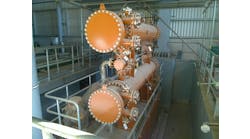Can you imagine starting a publication today called Equipment Preview for Process Industries Production Men? Probably, not. However, industry — and society — was different when that magazine, the predecessor of Chemical Processing, debuted in September 1938. With the Great Depression still lingering and the threat of war in Europe looming, some observers then might well have questioned whether the timing was auspicious for such a launch. However, Russell L. Putman, a veteran of nearly 20 years in the publishing industry, saw a need for the new magazine; our 70th anniversary testifies to his foresight and the enduring role that Chemical Processing plays in providing information to technical professionals in the chemical industry.
The mission of the new magazine was straightforward: “To keep you abreast of the latest developments in new equipment, new machines, new products applicable in process manufacturing … this is the sole purpose of Equipment Preview.”
Professor H. McCormack, director of the chemical engineering department at the Armour Institute of Technology (a predecessor of the Illinois Institute of Technology), Chicago, served as technical advisory editor for Equipment Preview. His background “as consultant and practical operator in chemical process manufacturing,” brought to the role an “unusual combination of the practical and the scholastic,” according to a write-up in that debut issue.
The dynamics of the industry that he recounted back then certainly should still resonate with today’s engineers:
“Chemical process production men live in a changing world and changing most rapidly are processes of manufacture and the equipment necessary for their satisfactory consummation."
“Leaders in the field have always prided themselves on their up to dateness.”
To serve such men (women engineers were scarce back then), the magazine declared: “… Every item published is selected because of its practical usefulness.”
The 16-page inaugural issue, of which 18,750 copies were printed, covered a wide range of equipment (as you can see online by clicking the on this link for the 1938 issue of Equipment Preview Process Industries for Production Men including:
- The Electrostatic Precipitron from Pangborn Corp., Hagerstown, Md., was claimed to provide 90% efficiency and to remove particulates as small as 1/5 micron.
- A high vacuum pump from Kinney Mfg. Co., Boston, Mass., produced vacuum below 0.001 mm absolute using a pair of pistons.
- Turbine transfer pumps from Aurora Pump Co., Aurora, Ill., reportedly combined the simplicity of a centrifugal with pressure development comparable to piston or rotary pumps.
- U-bolt gate valves from The Fairbanks Co., New York City, featured an extra-depth stuffing box filled with asbestos ring packing.
- A quick opening quarter-turn valve from Hills-McCanna Co., Chicago, promised leak-proof closure in the final setting of the diaphragm.
- A continuous rotary dryer from J. F. Devine Mfg. Co., Mt. Vernon, Ill., came with three stages, each with an independent steam jacket.
- Pressure filters for corrosive chemicals from R. P. Adams Co., Buffalo, N.Y., were available with either rubber or lead linings.
- Explosion-proof fans from Autovent Fan and Blower Co., Chicago, had wheels impregnated with Bakelite coatings.
- A centrifugal filter from Bird Machine Co., South Walpole, Mass., offered semi-automatic operation thanks to a timer.
- A new model rotameter from Fischer & Porter Co., Philadelphia, boasted unusual strength thanks to its heavy wall and true roundness.
- Temperature recorder-controllers from C. J. Tagliabue Mfg. Co., Brooklyn, N.Y., included an adjustable calibrated flapper on throttling models.
- Small self-contained cooling towers from The Marley Co., Kansas City, Kan., featured easily removable redwood decks.
- A new catalyst carrier from The Carborundum Co., Niagara Falls, N.Y., consisted of 3/16-inch-diameter, 3/16-inch-long cylinders of fused aluminum oxide.
The products in that issue provide a useful context for how equipment has evolved. Plants still rely on many of the items — of course in updated versions. All hardware then was undoubtedly American made, unlike today. And instrumentation and control, because it was so rudimentary, didn’t receive the emphasis it now does. Some of the companies remain familiar, but others have changed their names, merged or disappeared.
Equipment Preview, of course, also changed its name. The magazine became Chemical Equipment Preview with the January/February 1941 issue, Chemical Preview in May/June 1943, Chemical Processing Preview in May 1947 and, finally, Chemical Processing in January 1950. Putman Publishing (now Putman Media) still owns Chemical Processing, an increasingly rare situation in today’s turbulent media business.
Chemical manufacturing itself has changed dramatically over the years — and there’s no let-up in sight. Global competitive pressures, feedstock and energy issues and other challenges undoubtedly will spur continuing transformation of the industry.
Chemical Processing also continues to evolve. We still focus on “practical usefulness” but provide content on trends and developments that go beyond individual equipment. And we strive to be in the forefront in helping you address emerging issues — see, for instance, last month’s cover story on cyber-security (www.ChemicalProcessing.com/articles/2008/127.html). Beyond that, we now offer a wealth of information, including lots of content that doesn’t appear in the magazine, on Chemical Processing.com.
I’m glad to say that Chemical Processing at 70 remains spry and sprightly — and we intend to keep it that way.

